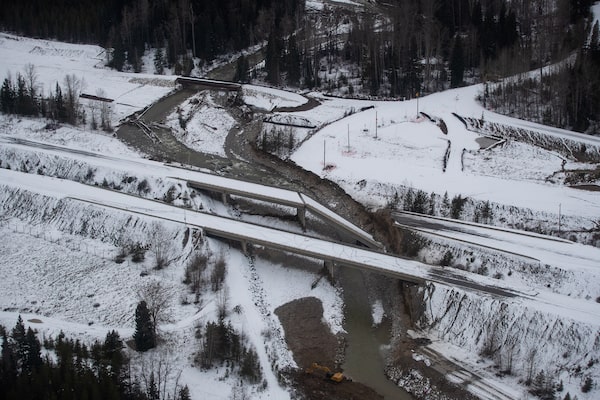
A collapsed section of a bridge sits in the water after severe flooding and landslides on the Coquihalla Highway south of Merritt, B.C., on November 22, 2021.DARRYL DYCK/The Canadian Press
Though protecting and restoring forests and wetlands offer cheaper, more effective ways to manage river floods and erosion, Canada continues to prefer large infrastructure projects, a new study has found.
The study, released Wednesday and prepared by the Intact Centre on Climate Adaptation at the University of Waterloo, determined that federal funding programs for climate change adaptation strongly favoured structural solutions such as erecting dikes and flood walls or modifying river channels. Alternatives that instead promote healthy ecosystems – known as nature-based solutions – continue to receive far less support.
“When dealing with flood risk, we’ve typically relied on ‘grey’ infrastructure, but the problem with that is that we are storing up maintenance commitments,” said the report’s author, Joanna Eyquem, managing director of climate-resilient infrastructure at the Intact Centre.
“And as demonstrated recently in B.C., grey infrastructure can fail, leading to catastrophic flooding. Whereas if we’re working with natural processes, we’re not subject to those failures, and it costs less to maintain in the long term.”
The report was prepared for the CSA Group, a national standards development organization. The first of the programs it looked at – the National Disaster Mitigation Program – funded 460 projects between 2015 and 2022; of those, only six employed nature-based solutions, all of which were in Ontario. (The Intact Centre was unable to isolate which NDMP projects addressed flooding and erosion.)
The second program studied was the newer Disaster Mitigation and Adaptation Fund, which funnelled money to 70 projects between 2018 and 2022. Of the 45 DMAF-funded projects dealing explicitly with river floods and erosion, just six used nature-based solutions, while another nine employed elements of them.
Flooding is Canada’s costliest variety of natural disaster, and damages are rising amid pressures from a warming climate, a growing population and other factors.
A wide array of nature-based solutions can be used to combat it. Some rivers, for example, were straightened historically; reintroducing meanders can slow the velocity of water moving downstream and reduce peak water levels.
Many rivers had embankments installed to prevent flooding on their former floodplains; removing these embankments can reduce flows, as can growing new forests on those floodplains. New woodlands grown along riverbanks can also reduce erosion.
“With nature-based solutions, what we try to do is soak up the water, allow infiltration, slow down the flow through reconnecting wetlands or natural floodplains upstream,” Ms. Eyquem said.
Community Forests International is a New Brunswick-based charity working with landowners to protect existing forests. Executive director Daimen Hardie said healthy forests act as “shock absorbers” at this time of year.
“When we have lots of rain, all the things that are growing in them, and the health of the soil especially, has this huge capacity to soak up a lot of water, and then slowly let that percolate through into the rivers,” he said. During the spring, he added, forest canopy provides shade that allows snowpack to melt more gradually.
“If that forest is cleared, when the rain hits the ground, the soil is compacted and doesn’t have that sponginess. And so the water quickly overflows the land and goes right into the waterways. And the waterways can’t absorb that really fast peak flow, so they flood.”
Yet even as organizations like Community Forests International work to restore forests, more are being degraded or harvested at a faster rate. Mr. Hardie said one-third of New Brunswick’s forests have been clear cut in the last 25 years.
Although nature-based solutions aren’t new, researchers acknowledge that more data are required to demonstrate the efficacy of many of these techniques. Ms. Eyquem said there’s limited experience with them in Canada, which further reduces willingness to try. But she added that other countries, particularly the Netherlands and Britain, already have more than two decades of experience.
Another challenge is that nature-based solutions typically achieve little at the local level; rather, they must be implemented holistically, throughout a watershed, to deliver desired results. Federal programs have tended to direct money to individual municipalities, which have limited authority to modify entire watersheds.
The Intact Centre report found that Ontario leads in implementing nature-based solutions in Canada, largely thanks to its conservation authorities, which have legal mandates to manage flooding and erosion within entire watersheds. Quebec is also moving toward managing at the watershed level, but many provinces lag behind.
“We found that there’s a drastic difference between the rigour that provinces put into watershed management,” Ms. Eyquem said. “Ontario leads the pack … other provinces are relying on a bunch of charities who are basically doing the best they can with the limited funds that they can scrape together.”
The CSA Group said nationally consistent standards are needed to encourage adoption of nature-based solutions and could be drawn up by the Canada Water Agency, a new Winnipeg-based body announced in the most recent federal budget. The government committed to providing $85.1-million over five years, and $21-million annually thereafter, to establish it.